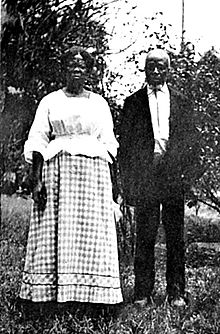- Cudjoe Lewis
-
Cudjoe Kazoola Lewis (ca. 1840 – 1935) is considered the last person born on African soil to have been enslaved in the United States when slavery was still lawful.
Contents
Life
Kazoola (his African name) was a native of Takon, a place north of Porto-Novo, Benin, where he was captured, and brought to the port of Ouidah. Together with more than a hundred other captured Africans, he was brought on the ship Clotilde to Mobile, Alabama, in the United States in 1860 during an illegal slave-trading venture.
When the slaves were divided among the investors in the deal, Kazoola and thirty-one other enslaved Africans were taken to the property owned by Timothy Meaher, shipbuilder and owner of the Clotilde. Due to a federal investigation, the Africans were at first left to fend for themselves. They quickly built shelters and started hunting game. While they could not lawfully be held as slaves, they were controlled by Meaher as if they were slaves. Five years later at the end of the American Civil War in 1865, slavery was abolished, and Lewis and his people were declared to be free.
Lewis and his tribespeople requested repatriation to Africa, but this was not arranged. He and other Africans established a community at Magazine Point near Mobile, Alabama which became called Africatown. They maintained their language and tribal customs for years and Lewis was very much a community leader, even meeting with prominent people such as Booker T. Washington. The neighborhood was also called Plateau and was eventually incorporated within Prichard, a suburb of Mobile. The suburb was later demolished in 1901, as a result of growing tensions between the blacks and the whites in the South.
Cudjoe was the longest-lived survivor of all those who were brought aboard the Clotilde and died in 1934 aged 94. He was believed to be the last African American born in Africa and brought to the United States by the transatlantic slave trade. Before he died, he gave several interviews on his experiences, including one to the writer Zora Neale Hurston. During her interview in 1928, she made a short film of Cudjoe, the only moving image that exists in the Western Hemisphere of an African transported through the Transatlantic Slave Trade.[1]
See also
References
- ^ Sylviane Anna Diouf at sylvianediouf.com
Bibliography
- Law, Robin, Ouidah: the social history of a West African slaving 'port', 1727-1892, Ohio State University Press, 2004, ISBN 0821415727
External links
- Sylvianne Diouf, Dreams of Africa in Alabama: The Slave Ship Clotilda and the Story of the Last Africans Brought to America, ISBN 0195311043
- Sonny Callahan, AfricaTown, USA, Local Legacies, American Folklife Center, Library of Congress
- Henry Willets, MOBILE COMMUNITY HOLDS ON TO UNIQUE AFRICAN HERITAGE, Alabama Arts, July 1993
Categories:- 1840s births
- 1935 deaths
- African-American people
- African slave trade
- African American history of Alabama
- American people of Beninese descent
- American slaves
- People from Mobile, Alabama
- United States history stubs
Wikimedia Foundation. 2010.

